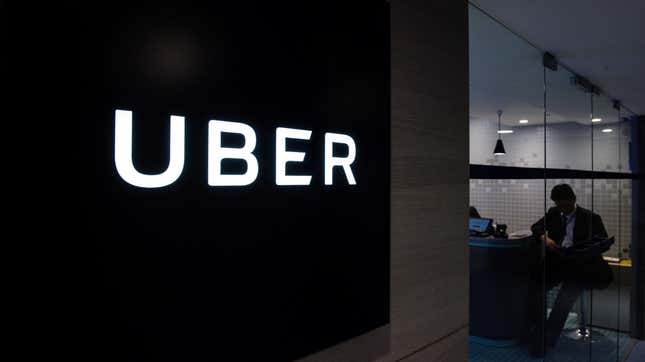
Although the covid-19 pandemic is still raging worldwide, big tech companies appear to be heartened by the recent developments over the last few months and are taking the first steps to bring their workers back to the office.
This week, Uber and Facebook announced timelines for a small percentage of their workforce to return to some company premises. Uber will reopen its Mission Bay offices in San Francisco on Monday at 20% occupancy, while Facebook plans to reopen select offices in the Bay Area on a rolling basis in beginning May at up to 10% maximum seated capacity. Microsoft will also open its Redmond, Washington headquarters and nearby campuses on a limited basis on Monday.
Returning to the office will be voluntary at Uber, Facebook, and Microsoft at the moment.
Uber spokesperson Lois Van Der Laan told Gizmodo on Saturday that as cities carefully return to a new normal, so will Uber. Going back to the office will be done on a voluntary basis, she said, adding that Uber’s work from home policy has been extended until Sept. 13.
Van Der Lann said the company’s reopening protocols are in line with public health guidelines.
“Our office reopening protocols meet (or exceed) global, national, and local public health guidelines, and are developed in partnership with public health experts and health and safety partners,” she said in an email. “Employees returning to the workplace need to take a virtual training, sign a COVID-19 Precautions & Acknowledgement form, and take a daily health screening (including temperature check) at home to qualify for return.”
Other measures in place include safety signage, social distancing placards, six feet (about two meters) of space between desks, and mandatory face coverings during the initial reopening phase. Uber is also ramping up its cleaning services for the office and says employees with symptoms, or who have family members who are sick, should stay home. When it comes to vaccines, Uber told Gizmodo that they will not be a requirement at this stage of reopening.
Facebook told Gizmodo on Saturday that it was moving from a single global work from home date to a site-by-site approach. The company said that employees have been given the option to work from home until July 2, and that following that date, any employee who is not a full-time remote worker may continue working from home until one month after their office reopens at 50% capacity.
According to Facebook, the latest data suggest the earliest the company will likely be able to open its largest sites at 50% capacity will be after Sept. 7.
“The health and safety of our employees and neighbors in the community is our top priority and we’re taking a measured approach to reopening offices,” Facebook spokesperson Chloe Meyere told Gizmodo. “As we return to the office, we have a number of safety protocols in place including physical distancing and masks required at all times when in an office, and where possible, weekly testing requirements for anyone working on site. We will continue to work with experts to ensure our return to office plans prioritize everyone’s health and safety.”
Many of Facebook’s offices, depending on where they are located, are in a different phase of reopening. In order to determine how and when to reopen, the company mainly looks at local health data, specifically local case rates, vaccination rates, and local access to testing and therapeutics, among other factors.
In terms of vaccination, Facebook will not require employees to get the vaccine in order to return to the office at this time. The company says the vaccine is safe and encourages employees to get the vaccine whenever they become eligible. It has recently launched a tool to help people find out where and when they can get vaccinated.
Microsoft executive vice president Kurt DelBene said in a blog post that Microsoft work sites in 21 countries had been able to accommodate additional workers in their facilities. Employees working at these sites represent about 20% of the company’s global workforce. Going forward, the company will be focusing on a hybrid workplace model.
In terms of its Redmond office, DelBene said Microsoft had been monitoring local health data for months and had determined the office could safely accommodate more employees on-site while complying with Washington state capacity limits.
“As we watch for progress against the virus in the region and continue to evaluate our guidance, employees who work at Redmond work sites or nearby campuses have the choice to return to those facilities or to continue working remotely, and also have the flexibility to do a mixture of both,” DelBene wrote.
He said that Microsoft had assessed all its work sites to understand what adjustments were needed to enable social distancing and meet local health standards. Employees on-site will be provided with supplies such disinfectant wipes and face coverings. Microsoft has also limited capacity in conference rooms, implemented attendance strategies, and posted signs in common areas to ensure social distancing, among other measures.
Gizmodo reached out to Microsoft on Saturday for comment on whether vaccines will be required for its workers who are returning to the office, but we did not hear back by the time of publication. We’ll make sure to update this blog if we do.
As far as other big tech companies go, the Verge reported that Google’s plans to return to the office are uncertain at the moment. In 2020, Google said it would allow its employees to work from home until September of this year. Apple CEO Tim Cook said in December that it seemed likely that the majority of teams wouldn’t be back in the office before June 2021, per Bloomberg. Twitter and Spotify, meanwhile, are allowing employees to work from home permanently if they wish.